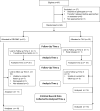A Pilot RCT of a Values-Based Mindfulness Group Intervention with Jail Inmates: Evidence for Reduction in Post-Release Risk Behavior
- PMID: 29242720
- PMCID: PMC5725200
- DOI: 10.1007/s12671-016-0636-3
A Pilot RCT of a Values-Based Mindfulness Group Intervention with Jail Inmates: Evidence for Reduction in Post-Release Risk Behavior
Abstract
This study pilot-tested a values and mindfulness-based intervention (Re-Entry Values and Mindfulness Program: REVAMP) in a sample of male jail inmates. REVAMP aimed to reduce post-release risky behavior by targeting dimensions of mindfulness (e.g., willingness/acceptance) and associated proximal outcomes/mechanisms of action (emotion regulation, self-control, shame/guilt). Inmates were randomly assigned to REVAMP (n=21) or treatment as usual (TAU, n=19). Attendance and feedback supported REVAMP's feasibility and acceptability. At post-treatment, ANCOVAs showed that the REVAMP group increased more on willingness/acceptance, self-judgment and shame relative to TAU. Relative increases in willingness/acceptance persisted at 3-month post-release. Criminal activity was assessed by self-report at three months post-release and official criminal records at three years post-release. At both time-points, there was a marginally statistically significant trend of medium effect size for lower criminal recidivism in the REVAMP group compared to TAU. There were no statistically significant differences in self-reported post-release substance misuse. This pilot RCT indicated mindfulness-based interventions may hold promise for reducing inmates' post-release risky behavior and encourages future research in this area.
Keywords: Criminal Behavior; Jail Inmates; Mindfulness; Substance Abuse; Values.
Conflict of interest statement
The authors declare that they have no conflict of interest.
Figures
References
-
- American Psychiatric Association. Diagnostic and statistical manual of mental disorders: DSM-IV-TR. Washington, DC: Author; 2000.
-
- Baumeister RF, Gailliot M, DeWall CN, Oaten M. Self-regulation and personality: how interventions increase regulatory success, and how depletion moderates the effects of traits on behavior. Journal of Personality. 2006;74(6):1773–801. - PubMed
-
- Baumeister RF, Vohs KD, Tice DM. The Strength model of self-control. Current Directions in Psychological Science. 2007;16(6):351–356.
-
- Bowen S, Witkiewitz K, Dillworth TM, Chawla N, Simpson TL, Ostafin BD, Larimer ME, Blume AW, Parks GA, Marlatt GA. Mindfulness meditation and substance use in an incarcerated population. Psychology of Addictive Behaviors: Journal of the Society of Psychologists in Addictive Behaviors. 2006;20:343–347. - PubMed
-
- Bowen S, Chawla N, Marlatt GA. Mindfulness-based relapse prevention for addictive behaviors: A clinician’s guide. New York: Guilford; 2010.
Grants and funding
LinkOut - more resources
Full Text Sources
Other Literature Sources



